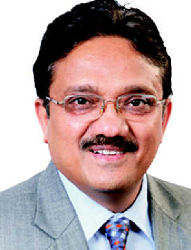SPECIAL FEATURE: GLOBAL INVESTORS MEET

Javed Akhtar, Chairman of Coffee Board
IN the late 1960s and early 1970s, good grade coffee beans and powder were in short supply in India. One could buy them only at specially established coffee depots. There would be long queues at these depots to collect a token to purchase the beans or powder. The beans would be taken home, roasted, ground by manual grinders and then used to produce the best-smelling, best-tasting filter coffee. Today, coffee is in abundance, and there is a wide variety of beans to choose from, thanks to improved methods of cultivation, increased production and the liberalisation of the Indian coffee industry.
The credit for promoting the flavour of coffee must go to the Coffee Board of India. Set up under an Act of Parliament in 1942, the Coffee Board is an autonomous body functioning under the Ministry of Commerce and Industry. Its main focus is on basic and applied research in coffee, quality upgradation and promotion of coffee in the domestic and international markets. The Coffee Board until 1995 had a pool (controlled) marketing system for coffee. With economic liberalisation, coffee production became a strictly private sector activity. The board’s Central Coffee Research Institute, located in Chikmagalur district in Karnataka, is one of the premier coffee research institutes in the world.
The Coffee Board will, without doubt, be one of the star attractions at GIM 2012, promoting coffee and showcasing its many flavours. On the eve of the GIM, Javed Akhtar, the Coffee Board Chairman, took some time off to speak to Frontline. Excerpts from the interview:
What plans does the board have to promote coffee?
Coffee consumption in the country has been growing at a rate of 5 to 6 per cent a year. At present, coffee consumption is over one lakh tonnes a year. From being a traditional beverage consumed mainly in south India, coffee has become a trendy beverage with a national presence, consumed in several forms. Its strong presence in the domestic market provides many avenues for enterprise development.
What has facilitated this growth in consumption?
The growth of the domestic market has been possible through the promotion of awareness and consumption of pure coffee. This has been done through generic promotional campaigns using mass media and participation in domestic events and festivals. To facilitate entrepreneurial development in the coffee value chain, the Coffee Board has been training people in coffee roasting and brewing. This business vertical is complemented by providing support for setting up roasting units.
The Deputy Chairman of the Planning Commission Montek Singh Ahluwalia has suggested that tea be declared the national drink.
I am not aware of any drink being declared as the national drink. Anyway, we don’t position coffee as competing with any drink.
How do you plan to attract investors to the coffee industry?
The strong growth in coffee consumption is throwing open opportunities for value addition. The outlook for this sector is much more attractive, given the continuing industry dynamism. The interest in the domestic coffee market can be seen by the high level of investment in the sector with the establishment of a Lavazza unit, the entry of Starbucks [which has a tie-up with Tata Coffee] and the arrival of Dunkin’ Donuts [a United States-based coffee and baked-goods chain]. It is also seen that the existing coffee retailers such as Café Coffee Day, Costa Coffee, Coffee Bean &Tea Leaf, Gloria Jean’s Coffee, Aromas, Au Bon Pain and Testa Rossa are planning to expand their businesses to capitalise on this enthusiasm for coffee. At the same time, small and medium roasting units and stand-alone cafes are also finding their way into niche coffee market development.
Growers complain of a lack of stability in coffee prices.
The price of coffee has never been stable. It depends on demand and supply, the quantity and quality of harvest, the powerful and influential secondary markets in London and New York. Though coffee is grown in developing countries, it is consumed in developed countries, so the state of the economy of these countries goes a long way in determining the price of coffee. What is needed to be provided to the grower is good/adequate returns in capital and labour costs.
Growers complain of a cartelisation of prices by big growers.
There are around 74 or 75 coffee exporters, among whom 10 are big. But there is no cartelisation of prices. There is also no abnormality of prices and it is a free and mature market.
Ravi Sharma
source: http://www.frontline.in / vol.29 , issue. 11 , june 02-15, 2012

